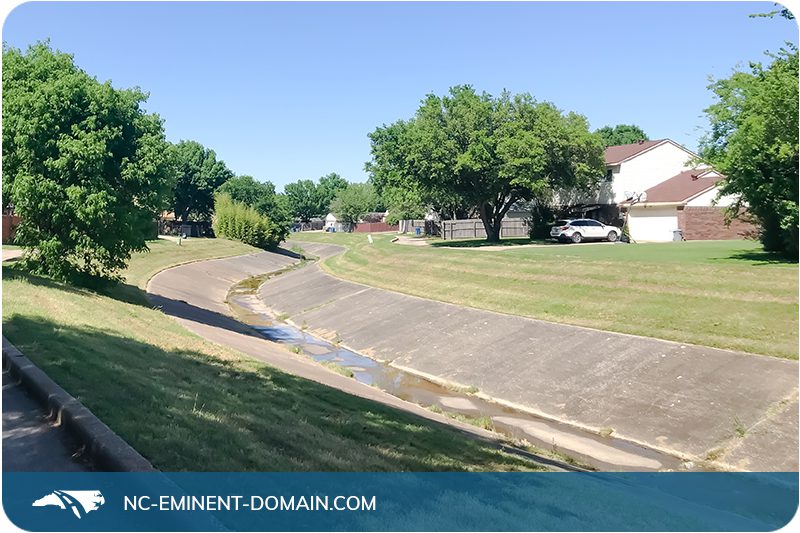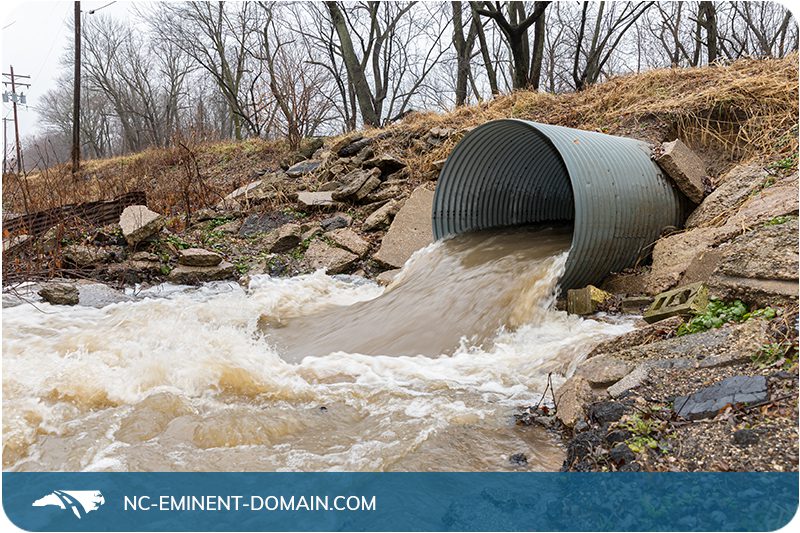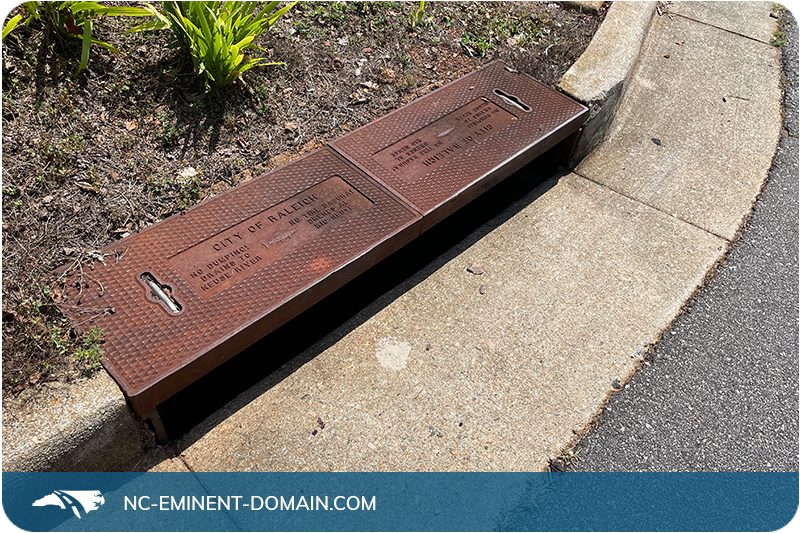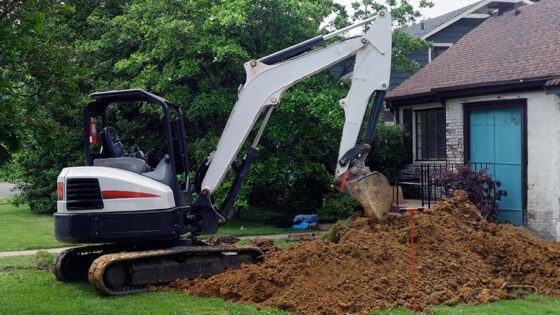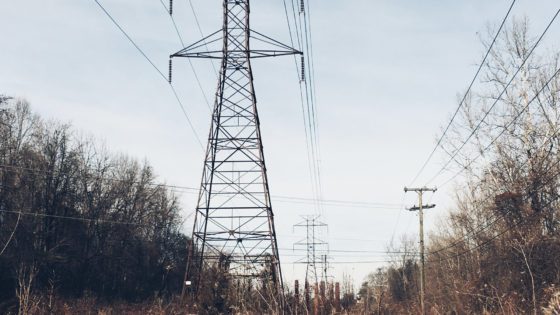Whether you’re a homeowner or have a commercial property interest, a drainage easement could have a massive effect on your land. It may limit how you use your land and gives the government the right to enter and work whenever necessary. And you’ll still be paying taxes and responsible for maintenance.
Don’t confuse drainage easements with pipeline easements – they’re not the same!
Don’t simply agree to a drainage easement without consulting an eminent domain attorney first – it’s a permanent change to your ownership rights. It could have a much more significant impact than you’re led to believe. Here’s what you should know.
What Is a Drainage Easement?
In simplest terms, a drainage easement is a right you grant to the government to enter your land and use a particular part of it for water management purposes. Note that’s two parts – access and use. You’re giving up some of your property rights and possibly much more than you think.
Understanding the fundamental facts about easements gets you halfway to understanding drainage easements. The rest is somewhat unique to this type of easement, and it can affect many things that are not obvious at a glance.
Are Drainage Easements Permanent?
Most likely the easement being purchased will be called a permanent drainage easement because it can, in fact, last forever. A drainage easement will be secured in writing and recorded at the county’s register of deeds, essentially appending it to the property’s deed. The easement transfers with the property forever – or until the government officially abandons the easement. We find this to be quite rare.
Who Owns Drainage Easements?
The land continues to belong to the property owner. However, specific rights to use the land are granted to the holder of the easement. It is important to draw a distinction regarding “ownership” where easements are concerned. If there is an easement on your property, it’s still your property. You still own and pay taxes on it.
What Does an Easement Look Like on Paper?
Most likely the document granting easement rights in your property will look similar to the deed originally granting you ownership in the property. There are a few semi-standard forms the NCDOT, for example, may employ. A grantor and grantee must reduce an easement to writing to be enforceable against future buyers of the property, so it will always have a signature or a place for one. We do not recommend that you sign one without consulting an attorney!
What Are North Carolina Drainage Easement Laws?
North Carolina enshrines its easement laws in various General Statutes that work together to create the rules. For a drainage easement (or any easement) to be enforceable, it must be in writing between the owner of the property (the grantor) and the entity receiving the easement (the grantee) and signed by all parties.
The pertinent statutes are:
- North Carolina General Statute 22-2 states that, due to the NC Statute of Frauds, changes to the boundaries of a tract of land or the establishment of an easement or right in or across the land must be in writing, signed by the property owner.
- In layman’s terms, North Carolina General Statute 39-6.4 means property owners can grant easements and reserve easements on their property.
- North Carolina General Statute 47-14(d) states that the easement does not affect anyone who does not sign the document.
- North Carolina General Statute 47-18 essentially states that no transfer of land rights is valid until registered with the county in which the property lies.
Of course, the government can compel property owners to grant them a drainage easement via eminent domain.
Public Drainage Easement or Private Drainage Easement?
In North Carolina, a drainage easement is generally a private easement, meaning that the public at large is not entitled to use of the easement. While the easement may be used for the good of the public and therefore “public use” by the letter of the law, it does not enable the general public to access the property or easement.
There is often some confusion here, as there can be private drainage easements between property owners which also include access rights. Generally speaking, drainage easements are private.
If the government is taking your land, follow these five important steps!
What Are Some Drainage Easement Examples?
Here are a few visual examples of drainage easements:
What Drainage Easement Restrictions Will I Have to Deal With?
A drainage easement can take many forms and significantly restrict what you do or how you use your property. Here are a few drainage easement examples:
- If a drainage easement is for a buried water pipe or underground drainage, you may be allowed to build a driveway or parking pad, but not a structure that requires a deeper foundation.
- If the easement is a culvert or a ditch, you won’t be allowed to build anything that would block or divert the drainage. Likewise, you are responsible for keeping the drainage area clear and maintaining the necessary slope of the land against erosion. Maintenance falls to the property owner!
- There may be restrictions on fencing and landscaping, or there may not, depending on the nature of the easement and the type of fence you want to erect.
- Access to the easement must be open if the government or utility needs to work in it. You may have to leave at least a portion of the land unimproved. Things like sheds, pools, tennis courts, basketball courts, or even swing sets and playhouses may be forbidden. Likewise, if you are allowed to build a fence, you may need to ensure the easement can be accessed by a gate and understand that considerable traffic may cross your property if repairs or upgrades in the easement are necessary.
These restrictions are not always clearly communicated and are the very characteristics that affect the value and usability of the property for the owner.
How Close Can I Build to a Drainage Easement?
Building near a drainage easement is risky. Water is always going to be nearby. What you can build and how close depends on the terms of the easement and what you want to build. Consult with the easement holder for the rules that apply. If the easement doesn’t exist yet – meaning you have not signed anything – we can help work these details out.
Is Landscaping a Drainage Easement Allowed?
Depending on the type of easement, landscaping may actually be required. As the property owner, you must keep the drainage easement maintained. Sometimes, that will mean cutting things that are growing in it.
For more aesthetic purposes, and again depending on the type of easement, you may be allowed to plant trees with shallow root systems or lay brickwork. Or you may not have any of these options. You’ll want to ask the permission of the government or utility that holds the easement before you proceed with any landscaping plans.
What Complications Could a Drainage Easement Cause?
A drainage easement can cause several problems for property owners. When you sell your home or business in North Carolina, you must disclose a drainage easement as a material fact. And, as drainage easements often imply water issues, they can chase some buyers away. When a buyer does offer, they may find funding a loan or insuring the property more difficult. Sometimes both!
Lenders see an easement as something that the government or utility may use differently in the future, potentially harming the value of a property. Depending on the size and nature of the easement, it may pose too much risk to the property’s value for a lender to stomach.
Meanwhile, an insurance company may see a drainage easement as a warning sign that the property has water management issues – not that they’re solved. As such, buyers and owners alike may be required to purchase additional flood hazard insurance depending on the size, scope, and location of the easement.
Who Is Responsible for Maintaining a Drainage Easement?
Typical property maintenance is the duty of the property owner. Things like the ditches at the front of a roadside property need to be mowed and maintained to prevent clogging. Property owners will have to deal with things such as:
- Cleaning up sticks, leaves, and debris after heavy rains or flooding
- Clearing out incidental debris from creeks and drainage ditches, like sticks, leaves, and grass trimmings
- Clear-cutting creek banks of vegetation as part of routine maintenance
- Mowing ditches or storm drains on the property, if applicable
- Regrading a storm drain to repair erosion or reseeding the area to prevent erosion
- Repairing damage to personal private property as a result of storm drain runoff or flooding
Some serious problems that may be the duty of the government or utility include:
- Removing fallen trees or large debris that create a drainage problem
- Clearing drain pipes, catch basins, and culverts
- Repairing and replacing broken drain pipes
- Controlling creek bank erosion that threatens water quality or property
- Repairing sinkholes that can occur over drain pipes
What Should I Do if There Is a Drainage Easement on My Property?
If the easement already exists, there is not much you can do. You can check with the register of deeds in the county your property is located. Easements should be recorded and searchable like the deed. They should also appear on surveys of the property completed after an easement was granted.
If your property is subject to an eminent domain taking for a drainage easement, you may have more options. While fighting an eminent domain taking may be risky and quite difficult, fighting for fair compensation for the land and rights you’re losing is worth the effort. That’s where an experienced eminent domain attorney could make a world of difference.
How Much Can I Get if the Government Wants a Drainage Easement on My Property?
Fair compensation for a drainage easement on your property will be a function of how much area it requires and how much it limits your ability to use and enjoy your property. Remember, a drainage easement may place some burdens on a property owner:
- Maintenance of the easement
- Taxes on a property you own but cannot utilize how you want
- Possible value reduction depending on the nature of the easement and proximity to improvements like houses or commercial buildings
- Insurance complications
- Third-party access requirements and interruptions
- Additional water flow through the property
- And more!
Don’t just take their word for it. We’ve found the government’s initial offer low more often than not. Contact us before you agree to an easement, and let us do some digging before the government or utility does!
How Can an Eminent Domain Attorney Help Me?
An attorney with experience with eminent domain and easements can help in many important ways.
Fight for fair compensation for what you’re giving up – We know what they’re doing with the land and how your rights will be limited. We have proprietary software that helps us as we guide our clients through the process. The real value of what you may be losing could shock you.
Reduced stress and hassles – Once we represent you, it’s as easy as “we’ll take it from here.” You’re still involved, and it’s still your property. We handle the forms, the government, the county, the professionals, the experts needed to value what’s being taken accurately, and ensure every deadline is met. We dot the i’s and cross the t’s while keeping you informed and equipped to make the best decision for you, your family, or your business.
An average of three times the original offer1 – Since we’ve been in business, we’ve helped our clients recover more than three times the initial offer for their property on average. We never touch a dime of the original offer and charge our fee only from the amount we help get above that original offer. And if we take your case and can’t get you more, you pay nothing.
Don’t hesitate to call us at 1-877-393-4990 for a free, no-obligation evaluation of your case. Or, contact us online right now – whichever is most convenient. Either way, it costs you nothing.

